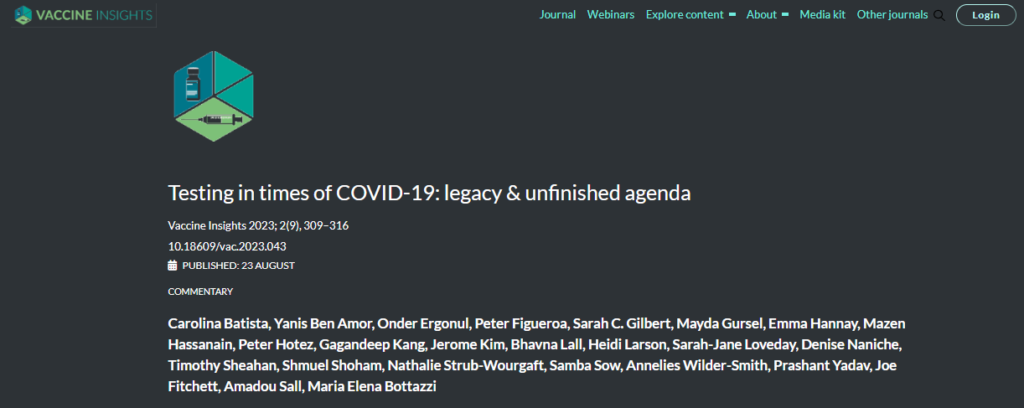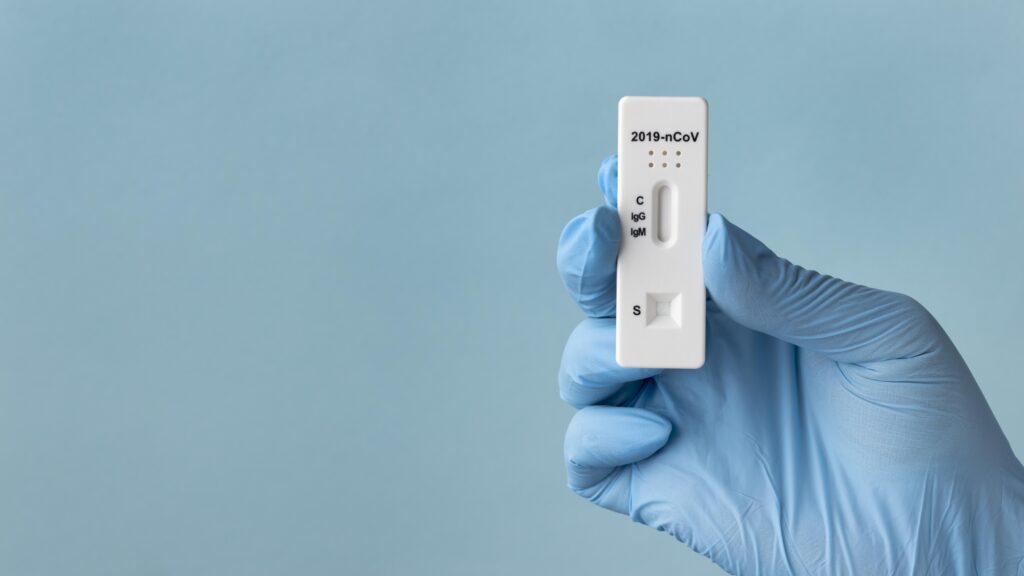the health strategist
institute for
strategic health transformation
& digital health
Joaquim Cardoso MSc.
Chief Research and Strategy Officer (CRSO),
Chief Editor and Senior Advisor
August 30, 2023
What is the message?
The article, published by BioInsights, underscores the crucial role of testing in pandemic preparedness, with a focus on the COVID-19 pandemic.
It highlights the stark disparities in diagnostic access, particularly in low – and middle – income countries, while also acknowledging the progress made in enhancing testing capabilities and policies.
The central message emphasizes the need for equitable access to diagnostics, leveraging innovations triggered by the pandemic to strengthen health systems, and advocating for well-coordinated research and development policies to address current and future health challenges.

Key takeaways:
- What is the main focus of the article “Testing in times of COVID-19: legacy & unfinished agenda”?
The article focuses on the importance of testing during the COVID-19 pandemic, highlighting the disparities in access to diagnostic tests, the progress made in addressing these disparities, and the lessons learned for the future.
- How has the COVID-19 pandemic impacted global health and development goals?
The pandemic has negatively impacted global health, social gains, and educational progress. It has disrupted the achievement of the 2030 Sustainable Development Goals and caused significant setbacks.
- What are some key statistics related to the COVID-19 pandemic as of December 2022?
By December 2022, there were over 645 million reported COVID-19 cases and more than 6.6 million reported deaths worldwide. The virus has continuously evolved, leading to the emergence of concerning variants.
- How are diagnostics important in pandemic response and preparedness?
Diagnostics provide crucial information for guiding public health decisions, identifying outbreaks, monitoring infection trends, evaluating immunity, and measuring vaccination impact. They inform policies, resource allocation, risk communication, and interventions.
- What are some challenges faced by low- and middle-income countries (LMICs) regarding diagnostics access during the pandemic?
LMICs have encountered disparities in diagnostic access due to factors such as lack of testing infrastructure, weak supply chains, and dependency on imported tests. They faced supply-demand imbalances, especially in the early stages of the pandemic.
- What progress has been made in COVID-19 diagnostics despite disparities?
Significant advancements have been made in COVID-19 diagnostics, including building in-country capacity for testing and improving policies. These initiatives support pandemic preparedness, healthcare delivery, and universal health coverage.
- What role have point-of-care (POC) diagnostics played in pandemic response?
POC diagnostics became crucial during the pandemic as they allowed easier access to testing, including self-tests. The adoption of POC tests has implications beyond COVID-19, potentially benefiting infectious and non-communicable diseases.
- How has the development of antiviral treatments influenced testing strategies?
Novel antiviral treatments offer opportunities for early intervention, emphasizing the need for decentralized testing. However, low testing rates in LMICs pose barriers to effective test-and-treat (T&T) approaches.
- How does the expansion of regional manufacturing capacity for COVID-19 tools contribute to pandemic preparedness?
Regional manufacturing capacity enhances flexibility and responsiveness of health systems to future pandemic threats. Local manufacturing can strengthen primary healthcare systems and address diagnostic needs in LMICs.
- What is the significance of genomic sequencing during the COVID-19 pandemic?
Genomic sequencing has been crucial for monitoring viral evolution, identifying variants, and informing public health responses. It has expanded rapidly globally, even in LMICs, but disparities in access and turnaround time persist.
- How can the innovations triggered by the pandemic be leveraged for better health outcomes?
The innovations in diagnostics resulting from the pandemic can improve health outcomes, strengthen health systems, and enhance global health security. The article emphasizes the need for equity in access to these tools.
- What is the article’s stance on R&D policies and access to diagnostics?
The article stresses the need for coordinated R&D policies based on public health needs rather than market demands. It advocates for timely access to diagnostics, especially in LMICs, to address current and future health crises.
DEEP DIVE

Testing in times of COVID-19: legacy & unfinished agenda [excerpt]
BioInsights
Carolina Batista, Yanis Ben Amor, Onder Ergonul, Peter Figueroa, Sarah C. Gilbert, Mayda Gursel, Emma Hannay, Mazen Hassanain, Peter Hotez, Gagandeep Kang, Jerome Kim, Bhavna Lall, Heidi Larson, Sarah-Jane Loveday, Denise Naniche, Timothy Sheahan, Shmuel Shoham, Nathalie Strub-Wourgaft, Samba Sow, Annelies Wilder-Smith, Prashant Yadav, Joe Fitchett, Amadou Sall, Maria Elena Bottazzi
August 23, 2023
Fast and effective testing is a critical part of pandemic preparedness and response; however, during the COVID-19 pandemic, there have been major disparities in access to diagnostic tests. Here, we outline barriers and progress toward equitable access to diagnostics during the COVID-19 pandemic and highlight important lessons learned for the future.
The COVID-19 pandemic has adversely affected the world in unparalleled ways, reversing decades of progress in health, social and educational gains, leading to severe disruption to the achievement of the 2030 Sustainable Development Goals [1] [2].
As of December 2022, 3 years after the first SARS-CoV-2 pneumonia cases were reported in Wuhan, China, there have been over 645 million COVID-19 cases and over 6.6 million deaths officially reported globally [3]. Since the virus was first identified, it has continuously evolved, leading to the emergence of distinct variants of concern (VOCs) that have caused surges and challenged existing public health structures. The deaths and disability from COVID-19 are expected to rise significantly when the full toll of the Omicron VOC and its return to China in early 2023 are fully considered and evaluated.
Diagnostics are a cornerstone for pandemic response and preparedness, as they provide essential intelligence to guide public health decisions. Effective access to testing can help identify outbreaks, monitor trends in infections, detect variations in incidence, evaluate community-level immunity and measure the impact of vaccination programs. Diagnostics can also inform policy and strategy development, resource allocation, risk communication, and evaluation of interventions.
However, stark inequities in diagnostics access have been reported since the onset of the pandemic, mainly in low- and middle-income countries (LMICs) where lack of testing infrastructure, weak supply chains, and high dependency on imported tests have left them vulnerable to the unfair supply-demand dynamics, especially in the early days of this global crisis [4].
Despite significant disparities, major progress has been made in COVID-19 diagnostics, particularly with robust investments to build in-country capacity to scale up availability. In addition, ongoing strategic initiatives spurred by the pandemic to improve policies and accelerate access to essential diagnostics at national and regional levels are paramount to support pandemic preparedness efforts, enhance healthcare delivery, and enable universal health coverage [5].
Among the main COVID-19 testing and surveillance milestones is the significant expansion in genomic sequencing capacity globally, especially in LMICs. This generated data that was instrumental to track viral evolution, identify variants, and provide evidence to guide public health measures, offering key opportunities for other disease control efforts, especially those of potential pandemic importance. Another achievement is the increased awareness and literacy around testing as a crucial element for an effective public health response.
Furthermore, the rapid acceptance of self-testing offers precedents for innovative public health strategies beyond SARS-CoV-2, in alignment with the increasing trends in uptake reported for human immunodeficiency virus and other infectious conditions in recent years [6]. In many LMICs, modern diagnostics and surveillance practices around COVID-19 may serve as the basis for strengthening their health systems but such gains need to be sustained and scaled as part of a fundamental change in the global health architecture [7].

Point of care diagnostics
The initial response to the coronavirus pandemic was hampered by health systems’ heavy dependence on laboratory-based diagnostics. With COVID-19 lockdown measures and mobility limitations, point of care (POC) diagnostics experienced a steep growth in adoption as they enabled improved access to individuals, including via home tests. Coronavirus POC tests’ easy-to-use applicability shifted the perception of their usefulness by healthcare providers and the general population. Furthermore, the potential applicability of these tools beyond COVID-19, including for infectious and non-communicable diseases has been documented as a means to bring diagnostics closer to patients and empower users [8] [9].
The urgency to further invest in the development of novel POC multi-pathogen testing has also emerged. These platforms offer crucial opportunities to center health systems around patient needs, improve surveillance, and transform diagnostics and management of multiple infectious threats, including pandemic-prone diseases. Some of the molecular platforms developed for SARS-CoV-2 can be re-engineered for other pathogens and pivoted to address unmet diagnostics needs [9] [10]. Sustained investments, collaborations, and concerted actions will be required for this approach to reach its full potential, mostly in LMICs where these tools can fill public health gaps, to address major global concerns such as tuberculosis (TB), arboviruses, and endemic conditions such as Ebola, Mpox, [11] [12] and others. In addition, manufacturers of POC diagnostics cannot sustain a ‘feast or famine’ demand. Single pathogen diagnostics will continue to face ups and downs in demand, but multiplex diagnostic platforms can be a better mechanism to stabilize demand.
Test & treat approaches
The development of novel antiviral treatment and/or prophylactic options for SARS-CoV-2 has been one of the great biomedical milestones of the pandemic [13]. It also offers an opportunity to halt the impact of infection in individuals, especially those with a higher risk for severe disease, as well as an opportunity to mitigate the burden on the most fragile health systems. The short window for treatment initiation required by novel antivirals calls for timely decentralized access to testing, including standardized self-testing approaches [14].
Testing rates remain low in LMICs and represent an important barrier to the successful implementation of test-and-treat (T&T) approaches [15]. The COVID Treatment Quick Start Consortium was recently founded to expand access to novel antiviral drugs in LMICs [16].
In order to maximize the public health potential benefit of novel antiviral drugs, major strategic investments will be required to scale up availability and access to diagnostics and healthcare infrastructure, technical capacity, resourcing, and staffing. Strong advocacy and community engagement at the country level are essential to co-design strategies and campaigns, as well as to tailor messages to the general public, opinion leaders, and high-risk groups. UNITAID and FIND are working with local stakeholders and advocacy partners in LMICs to coordinate programs to boost the potential impact of this initiative in these settings [17]. Experience in high-income countries that launched T&T programs for COVID-19 demonstrated that including pharmacies and other healthcare facilities closest to the patient is an imperative for T&T to succeed. Future preparedness to deploy T&T in LMICs requires a model that involves private pharmacies in LMICs with the technical capability and data-sharing infrastructure [18].
Regional manufacturing capacity
The urgency to expand regional manufacturing capacity for COVID-19 tools has been a recurrent theme since the onset of the pandemic. Multi-stakeholder partnerships and robust investments in technology transfer happened in response to COVID-19 and beyond [19]. Such investments in local testing capacity offer crucial opportunities for the creation of flexible platforms that can prepare health systems to respond to future pandemic threats. Furthermore, investments in local manufacturing capacity will contribute to more robust primary healthcare systems to better respond to the evolving needs of populations in LMICs [20]. It is promising that strengthening regional manufacturing of diagnostics has been taken up alongside other medical countermeasures by India as part of the agenda for their G-20 presidency this year [21]. The business model for local manufacturing of diagnostic tests may require advanced commitments from purchasers, or price premiums in the short term, but these are important for jump-starting a local industry for diagnostics whose benefits go beyond just resilience in supply. This will lead to new avenues for developing and manufacturing of test kits for diseases with small market sizes.

Genomic sequencing
The COVID-19 pandemic has catalyzed the rapid expansion of genomic sequencing capacity worldwide. Genomic surveillance has been crucial to monitor pandemic evolution and has enabled the identification of various viral lineages that fueled multiple pandemic waves, including the emergence of VOCs. By providing an accurate landscape of viral evolution and distribution, it also has the potential to guide public health responses, and optimize treatment, vaccines, and molecular test development [22].
Before the pandemic, genomic sequencing activities were primarily limited to research initiatives and a few other vertical disease programs, especially in LMICs. In Africa for example, 38 countries have built next-generation sequencing infrastructure to address the coronavirus crisis, a significant increase from only seven countries in 2018 [23]. The Africa Centre for Disease Control and Prevention (CDC) has spearheaded the Africa Pathogen Genomics Initiative (Africa PGI) which aims to increase disease surveillance and public health partnerships to leverage genomic sequencing technologies [24]. Similar initiatives have taken place in Latin America and Asia [23].
Despite the fast expansion of sequencing capabilities at the country level, it has not yet reached its full public health benefit and major disparities persist, following similar inequity trends of the pandemic. During the first two years of COVID, 78% of high-income countries (HICs) sequenced more than 5% of their COVID cases, whereas, in LMICs, only 42% of countries reached that level. Similar disparities have been observed with regard to turnaround time (TAT), with around 25% of HICs submitting samples for sequencing within 21 days, while only 5% of LMICs achieved that level [25]. Despite major achievements triggered by the pandemic, sustained investments are needed to achieve equity in access and wider availability of genomic sequencing capacity. PGS labs face uncertainty in future demand as the demand for COVID-19 sequencing fades away. Standardized end-to-end workflows for different pathogens and applications, NGS laboratory and bioinformatics training, supply chain optimization and other such efforts have to be put in place to make PGS sustainable in the long term.
The new WHO rapid communication issued this July for the use of sequencing for the diagnosis of drug-resistant tuberculosis represents a landmark move for sequencing from a tool for research and surveillance to a tool to improve clinical care for patients [26]. Strong genomic sequencing capacity can improve pandemic preparedness, strengthen surveillance efforts, supporting countries at higher vulnerability for emerging threats and current epidemics (for example, improve TB clinical management and pave the way to achieve global targets for TB), among others. Investing now in expanding local genomics capacity will benefit not only individual countries but global health security more broadly.
Conclusion
While being one of the most devastating health challenges of our time, the coronavirus pandemic did spur unprecedented progress in biomedical innovations, including diagnostics. However, innovations have not reached lower-income countries at the pace seen in high-income countries. Ultimately, the impact of the crisis has been disproportionately higher among the world’s most vulnerable, primarily due to unequal access to novel tools and systemic barriers to health care. Peeling et al. have highlighted how the innovations and investments in diagnostics triggered by the pandemic can be leveraged to improve health outcomes, strengthen health systems, and advance global health security [27].
There is growing consensus that strong pandemic preparedness and resilient health systems should be grounded in equity principles. While much of the priority has been directed at global equity for vaccines and vaccinations, diagnostics also demand our attention [28]. This will be true not only for COVID-19, but as highlighted above for many neglected diseases including TB and malaria. The diagnostic equity gap is especially glaring for neglected tropical diseases of regional importance, such as Buruli ulcer, leishmaniasis, or Chagas disease, that fall below the radar screen of multinational companies.
In addition, there is an urgent need for well-coordinated R&D policies based on public health needs, not market demands. These policies need to be translated into timely access, with emphasis on stronger regional capacity, especially in LMICs where the reliance on philanthropy and development assistance has historically left their populations vulnerable to lengthy timelines in innovation adoption and fragile supply chains. Maintaining and expanding investments in diagnostics development and access that were triggered by the pandemic offers important opportunities to respond not only to COVID-19 but to other current crises, infectious and non-communicable diseases, and prepare for future epidemic threats, and in the worst case, pandemics.
References
This is an excerpt of the original article. See the original publication for more information.
Authors and Affiliations
Carolina Batista
Baraka Impact Finance, Geneva, Switzerland
and Movement Health Foundation, Geneva, Switzerland
Yanis Ben Amor
Center for Sustainable Development, Columbia University, New York, New York, USA
Onder Ergonul
Koc University Research Center for Infectious Diseases, Istanbul, Turkey
J Peter Figueroa
University of the West Indies, Mona, Kingston, Jamaica
Sarah Gilbert
Jenner Institute, Nuffield Department of Medicine, Oxford University, Oxford, UK
Mayda Gursel
Middle East Technical University, Ankara, Turkey
Emma Hannay
FIND, Geneva, Switzerland
Mazen Hassanain
College of Medicine, King Saud University, Riyadh, Saudi Arabia
Peter Hotez
Texas Children’s Hospital Center for Vaccine Development, Baylor College of Medicine, Houston, Texas, USA
Gagandeep Kang
Bill and Melinda Gates Foundation, Washington, USA
Jerome H Kim
International Vaccine Institute, Seoul, South Korea
Bhavna Lall
University of Houston, Tilman J Fertitta Family College of Medicine, Houston, TX, USA
Heidi J. Larson
London School of Hygiene & Tropical Medicine, London, UK
Sarah-Jane Loveday
FIND, Geneva, Switzerland
Denise Naniche
ISGlobal-Barcelona Institute for Global Health-Hospital Clinic, University of Barcelona, Spain
Timothy Sheahan
University of North Carolina, Gillings School of Global Public Health, Chapel Hill, NC, USA
Shmuel Shoham
Johns Hopkins School of Medicine, Baltimore, USA
Nathalie Strub-Wourgaft
Drugs for Neglected Diseases Initiative, Geneva, Switzerland
Samba O Sow
Center for Vaccine Development, Bamako, Mali
and University of Maryland, MD, USA
Annelies Wilder-Smith
Heidelberg Institute of Global Health, University of Heidelberg, Heidelberg, German
Prashant Yadav
Center for Global Development, Washington, DC, USA
and Harvard Medical School, Boston, MA, USA
and INSEAD, Fontainebleau, France
Joe Fitchett
Institut Pasteur de Dakar, Dakar, Senegal
Amadou Sall
Institut Pasteur de Dakar, Dakar, Senegal
Maria Elena Bottazzi
Texas Children’s Hospital Center for Vaccine Development, Baylor College of Medicine, Houston, Texas, USA
Originally published at https://insights.bio/vaccine-insights












